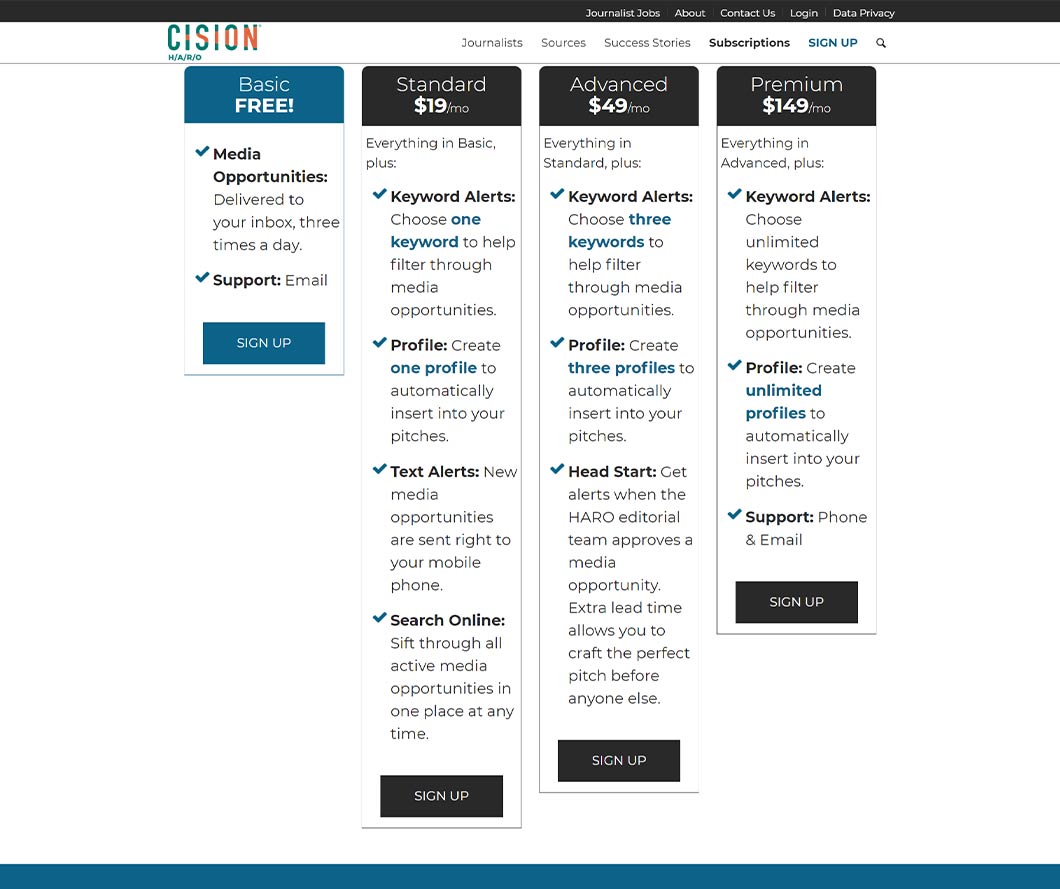Consumers and business owners want to know what their peers think. You can deliver insights to your audience using free and paid services from the Help a Reporter Out (HARO) platform. Use this crowdsourcing service to pitch yourself as an expert or get crucial insight from specialists. Learn what HARO is and how to get the most out of it.
What Is HARO — and How Does It Work?
HARO is a platform that lets journalists and bloggers ask questions and people answer. According to Wired, HARO began as a Facebook group to connect reporters to sources.
It was later acquired by Vocus, which merged with Cision, a public relations (PR) software and services company, in 2014. Cision reports HARO connects more than 55,000 journalists and bloggers from 100,000-plus outlets to more than 250,000 experts.
HARO lets eligible outlets submit requests for quotes. Subscribers can respond to queries or make a pitch. You also can request product gift bags for use at an event or products costing $100 or less for reviews.
In short, HARO is both a platform for sourcing quotes and service as it has an editorial board that vets incoming source requests.
Once HARO accepts a query, HARO publishes it on their platform and includes the question in one of its 3 daily email digests. Emails go out to subscribers Monday through Friday at 5:35 a.m., 12:35 p.m. and 5:35 p.m., Eastern time.
In some cases, HARO also tweets queries to its audience of 122,700-some followers via @helpareporter. Typically, HARO only tweets 1-5 times a day for last-minute requests deemed urgent.

HARO Qualifications to Request Sources
If you want opinions from sources, it’s best to read through HARO’s guidelines for outlets.
The basic eligibility requirements include:
- Your website needs an Alexa ranking of one million or less
- The business or website must be at least one month old
- You must add the requester’s name, not a general term like “staff”
- Requesters must properly quote their sources
- You can’t ask for responses of more than 300 words
- If you require a subscription for your online publication, you can’t use HARO
- You can’t request a backlink, money or other actions from a source
Guidelines for Answering HARO Requests
Sources have fewer requirements than outlets, and it’s up to the requester to verify responses.
The basic HARO guidelines for sources are:
- Be able to demonstrate expertise in the topic area
- Provide unique content that hasn’t been published elsewhere
- Can’t require a backlink from outlets that use your quote
- Don’t attach files to your email reply as the HARO platform removes them
HARO Plans and Pricing
If you’re an organization seeking insights from subject matter experts (SMEs), the HARO platform is free to use. Likewise, it’s free to answer queries after you sign-up for the platform.
However, if you’re using HARO for publicity, you may want to buy a monthly subscription to save yourself time.
There are 4 HARO plans, including:
- Basic: Free to receive 3 emails a day with HARO requests.
- Standard: $19 a month to see requests via text or the HARO platform, 1 keyword for filtering queries and a profile you can add to your responses.
- Advanced: $49 a month for 3 keywords, 3 profiles and a notification when the HARO editorial team approves a journalists’ query.
- Premium: $149 a month for unlimited keywords and profiles and support through phone or email.
The Benefits of Using HARO
Many business publications, including Fast Capital 360, use HARO to get tips and expert advice from industry professionals.
The quotes may be blended into content on a blog, print publication, or referred to during a podcast. Using HARO is usually a strategy that complements your marketing plan and goals.
Indeed, it’s a good content marketing strategy, as people tend to trust their peers over a brand. You give your audience access to expert insights, earning their loyalty.
Your quoted sources may share your article with their social media followers or email subscribers, increasing your website traffic. Also, many business professionals respond to HARO inquiries as a PR effort to gain publicity for their name or business.
Sources who feel they’re experts in the topic and want to share their tips with the chance of increasing their personal brand awareness and that of their company. Often, outlets will include a link to the expert’s website or LinkedIn profile, which could increase their web traffic.
How to Make a HARO Request
Submit a HARO request by completing the query form. You’ll need to fill out basic information, such as your full name, title, company name and business website.
Next, HARO asks for a summary, like a headline or an email subject line, telling the reader what to expect.
The query is where you give some background and ask your main questions.
If you have specific requirements, there’s a box for that also. For instance, you could request quotes from consumers who’ve hired a roofing contractor in the last 3 months or from restaurant owners with fewer than 300 employees.
The sky’s the limit here. Listing requirements reduce the number of unqualified messages you receive, but it also can narrow down the field of people who’ll reply.
Lastly, you need to choose a primary and secondary category. This step is important because sources sign up for emails in certain sections, so not everyone will see your query.
The categories include:
- Business and finance
- High tech
- Biotechnology and health care
- Energy and green tech
- Lifestyle and fitness
- Sports
- Entertainment and media
- Public policy and government
- Education
- General
- Gift bag
- Travel
- U.K.
HARO Request Best Practices
Most HARO best practices also are tips for being a good communicator. As in real life, if you continually get poor or no responses, you may want to check your approach.
Use these tips to get the most out of your HARO requests:
- Be professional and concise: Write a query like an email you’d send to another business professional. Short, scannable and edited for errors.
- Ask specific questions: A HARO query is like an interview minus the one-to-one interaction. Include open-ended questions and provide follow-up queries to help the respondent form their answer.
- Set reasonable requirements: If you want a veterinarian to respond and not a vet tech, say so. If your guidelines are minimal, still write something. Otherwise, you’ll get an answer on behalf of a famous dog on Instagram.
- Vet the respondents: You don’t want your name or brand connected to a bad seed in today’s world. Take a quick look at their social feeds and profiles to ensure your “expert” won’t embarrass your company.
- Check responses for plagiarism: Many HARO respondents send the same response to multiple outlets. Others cut and paste content that isn’t theirs. Always use a plagiarism tool to weed out responses that appear elsewhere.
In addition, keep in mind that your sources may prove valuable now and in the future. Take the time to let them know when you publish the article and, when appropriate, tag them in your social media posts.
At the same time, respect their space and time. Don’t spam sources with messages requesting they share your article, visit your website or reciprocate with a backlink.

How to Respond to a HARO Query
If you’re a free HARO user, you can reply directly to source requests from the HARO digest. Paid users also can respond on the HARO platform.
Every response should include:
- An introduction quickly explaining why you’re a good source for the topic
- Profile details, such as your full name, job title and website
- A pitch that follows the provided instructions
- A call-to-action (CTA) telling them you’re available to answer further questions
HARO Pitch Best Practices
Along with a speedy reply, HARO sources can make their response stand out by following PR best practices. You’re pitching a business or writer, not text messaging your friend.
Use these tips to become a HARO professional and score media mentions:
- Be authentic: Requesters may use publicly available data to verify who you claim to be, so don’t try to invent a job title just because you’ve done similar tasks in the past.
- Don’t plagiarize: Every word you state in your reply should be original unless you’re adding a statistic and backing it up with a source.
- Use canned responses sparingly: Few publications want to share exact quotes used on other websites. Don’t send the same reply to multiple publications.
- Build a profile template: Create a document with HARO profile data, including your name, title, business name, elevator pitch and social media links.
- Tailor your response to the publication: Check out the website style if the outlet name is listed. Writing a quote for a lifestyle publication may be less formal than a business-to-business (B2B) blog.
- Edit yourself: Journalists scan through dozens of replies for quotes that stand out. A few stellar sentences are better than 400 rambling words.
Sites Like HARO: 4 Alternatives
Although Help a Reporter Out is easy to use, it can be time-consuming. You may want to try HARO alternatives for standalone sourcing or to add diversity to replies from the HARO platform.
Ask questions or submit pitches on sites like HARO, including:
- Twitter: Come up with a 280-character question, add an image with the question if you have time and use the hashtag #journorequests.
- Quora: Ask or answer a question on Quora. But, don’t use it for content on your website unless you quote it from Quora, as it could harm your search engine optimization (SEO) efforts.
- PR agency: Work with a PR or marketing agency to find opportunities for media mentions. They send out emails to writers offering quotes on your behalf.
- Facebook groups: Local businesses can find experts in community groups. There are also many writing, marketing and PR groups that connect people to experts for interviews.
Give or Get Advice by Using HARO Effectively
Use HARO as part of your PR and marketing strategy to increase brand awareness and website or social media traffic.
It’s free, and it gets easier when you get into a rhythm of asking the right questions or pitching. Plus, your expertise or that of fellow specialists helps your audience.











